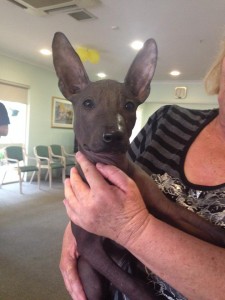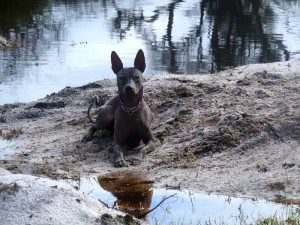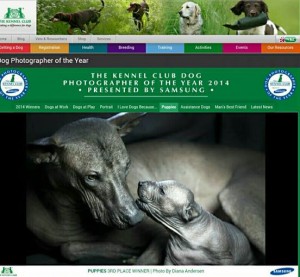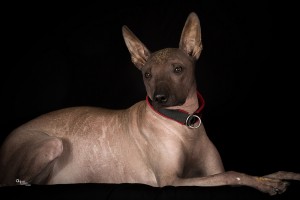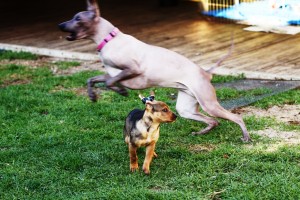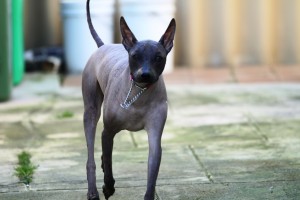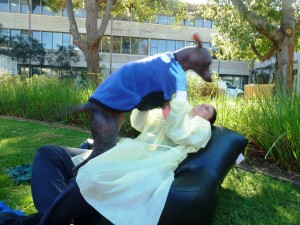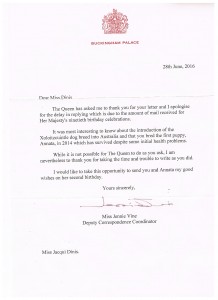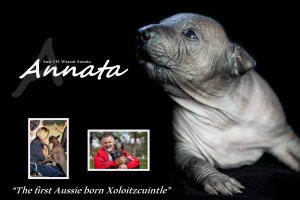 2014….PRAA and secondary ME, I remember those words echoing around in my head and trying to grasp what on earth they meant, clutching a 33 day old puppy at my vets. Little did I know this would be by far my biggest challenge ever, and If I knew then what I know now, I would have been TERRIFIED!
2014….PRAA and secondary ME, I remember those words echoing around in my head and trying to grasp what on earth they meant, clutching a 33 day old puppy at my vets. Little did I know this would be by far my biggest challenge ever, and If I knew then what I know now, I would have been TERRIFIED!
PRAA is not common, and not hereditary, (however it is known in some breeds more so than others). During development in the uterus, the fetus has a right and left aortic arch, generally the left aortic arch forms the main artery that extends off the heart and travels to the abdominal region. If the right aortic arch develops into the aorta, the esophagus becomes trapped by a ligament that extends from the pulmonary artery (vessel that pumps blood to the lungs) and the aorta. This stricture is removed during surgery allowing food to pass through the esophagus to the stomach. With PRAA an incision is made on the left side of the chest through the ribs to expose the stricture band that constricts the esophagus. The constricting band/stricture is isolated and tied off then cut, fibrous tissue that may be constricting the esophagus is dissected off the esophagus.
This is the Story of Wazzat ANNATA (the first born Xoloitzcuintle in Australia)
The birth of the first Xoloitzcuintle last year in Australia was a well anticipated event, albeit just the one, it was indeed an exciting time for us, who after six years of waiting, trying every imaginable option that had met with failure, we finally had a little luck. All was going well until around 28 days, I noticed Annata the puppy was not swallowing milk and it appeared to be coming out from her nose and mouth, almost like there was something stuck in her throat. I attended a vet at three in the morning after she had a choking attack that just wasn’t right, they put it down to guzzling and her being a pig. A few days later I attended my usual vet after she had lost weight and just wasn’t doing well, she would constantly regurg milk and become very distressed. The vets diagnosed possible PRAA (Persistent Right Aortic Arch) with secondary ME (Mega esophagus) and aspiration pneumonia, I was given some Vet options and teaching hospitals to attend (varying in price up to $15,000) but I chose a vet who had treated the family dogs for many years instead. After the two hour drive, my vet arranged with the specialist vet we could attend immediately and operated on Annata that day, she was 33 days old.
It was touch and go and she was resuscitated on the table straight after surgery, she was taken home that night and no doubt kept the vet up all night, he did comment everyone in the units where he lives will now know the sound of a Xoloitzcuintle. Annata was operated on and came home the next day, she had developed aspiration pneumonia which is common when regurged milk/ food can travel back to the lungs. Syringe feeding such a tiny puppy was in the least terrifying, I worried I would overfeed, underfeed, was it too hot too cold. Within a few days Annata was back to being a cheeky puppy, despite a huge line of stitches stretching almost her whole body, (and on her show side too!) She seemed happy and active and as always very hungry.
.
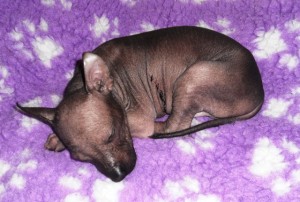
33 days old the day of the Operation at Swan Vet Hospital Midvale
But somehow we managed through to the ten week checkup, at the vets a Barium meal is ingested and this shows the esophagus and the process of the food travelling through. I could tell when the vet came out of the exam room, it wasn’t all good, he explained although the stricture had been removed the esophagus had not grown in keeping with the dog and was basically still a 33 day old sized esophagus (1 / 2 mm) . We had spoken about could he dilate the narrow part using a balloon catheter, however as the part of the esophagus was paper thin he was afraid it would tear with pressure, so we decided to wait and recheck at 6 months, with a view to surgery to cut and repair the paper thin area at 12 months. During these first 11 months Annata has required constant care and three hourly slush feeds during the day from 7 am to 10 pm, (all dependent upon how many regurges we have during the day.) We feed her normal food, kibble soaked and blended, beef and lamb that is minced then cooked then blended (we learnt after two blenders that an Industrial blender was the only way to go) My husband prepares the slurry feeds each week in a process where Annata comes running to the sound of the blender and is all ears and eyes in anticipation! Annata leads a normal life, she just can’t have kibble, bones, chews or anything that will not either crumble or slide down her throat, she also mages to eat Kangaroo poop with no adverse effects, she needs to be watched constantly, muzzled or crated (which she detests). Occasionally she will steal a chew from another dog, commandeer a bone and I won’t know she has eaten this until meal time when she eats her slurry. Tell tail signs are when she gets all glazy eyed, arches her back and her throat swells up like a football, this is the food getting blocked up behind the obstruction narrow point. Sometimes food can pass this and sometimes it can sit in the esophagus and rots, a few days of rotting food, in regurgitation is not nice I can assure you. I am now used to picking through the regurgitation to see what it is she has ingested, and usually it is my fault for not closing a door, not being quick enough, however it’s hard to not let her be a normal dog with the big kids. The funny thing is she can easily eat Prawn Crackers (her favourite) and Arnott’s Shortbread biscuits, as they both just melt in her mouth, in fact I get into trouble if I touch Ananta’s shortbread biscuits! We hit the 12 months where we were too decide if we wanted the vets to operate to see if they can fix the focal narrowing, if it is still thin and something goes wrong that’s it, Goodnight Annata, there is no room for mistakes. I tossed up with the idea of a stomach feeding tube, but that’s not an option for such an energetic dog, I ask myself am I being selfish by having the operation? Can I just keep going with the constant care and three hourly feeds, doggy day care or a dog sitter (thank you Gaye North and D for Dog Bunbury) I do get angry at times as it’s 100% full on, I can’t even close the toilet door. On the odd occasion I get to the shops and marvel at everything I am that anxious to get back to Annata it spoils the trip, I’ve often asked myself if I need counselling being this attached to the dog and the dog to I.
So when the 12 months approached I told myself when we get to the end of this journey I want to say “We gave this journey all we could, where, when and how it will end is beyond us, but we gave it all we had.” 12 months came and we booked to see the vet Dr Ross STAADEN, when Dr STAADEN came out to examine Annata, he was met by three Xolos (Pitaya, Taha Daha and Annata) I kid you not, his words were “Which one is Annata?” I was so proud, puffing my chest out I said “This one I” I said pulling her forward, Dr STAADEN was impressed and stated he had not seen a dog with her eating problems in this condition, I know he didn’t expect to see us back at all. After checking worldwide for information on the operation we were both unsuccessful in going any further and as the four layers of esophagus had to be cut and re stitched together ( think four strands of hair) I could not take the risk of losing Annata and Dr STAADEN said we were doing a good job so why risk her life.
Some may say it’s a cop out, a lot say I waste my time as she is of no value to the Xolo gene pool or the breed, but they are WRONG and that’s very sad because Annata has given hope to so many through her battles, and spread her mischief all over and gained quite a following worldwide, I KNOW I would not be able to cope if anything happened to her as I made the wrong choice, so we just battle on, as best we can with the support from our friends and family.
Would I do it again people ask, I’ve been told I am silly for persisting with the dog after all what good is she to the breeding of the Xolo here in Australia, people fail to realise I bought this dog into the world and in my belief as a breeder I must do ALL I can for her for as long as possible. Annata has made many friends around the world, we have given advice and help to others with PRAA and what we believe is a little bit of hope in what at times can feel like a really bad ride. Annata even made it to Crufts in the photo competition, where Diana Andersen of Animal Images won third place with a photo with her dam Pitaya. Annata has been on the television multiple times and in countless papers, she even found the time to gain her Australian Championship title, thus becoming the first ever Aussie bred Xolo to title. I share her story with anyone who is interested as we know one day it will just be a chapter of a brave determined little dog who wouldn’t give up and gave hope to many.
Most will never know as I am bound to privacy by the owners of other PRAA dogs not to tell their story, but I can proudly say Annata and her story have saved many here in Australia, and I am so glad that by telling our story some others will benefit and can tell others, whilst realizing not all can be saved, it’s nice to know that people will have a go because of a little battler who gives it her all, thank god, no other dogs have had the same esophagus problem as in the none growth after the stricture removal. We are still searching to find someone from anywhere in the world with this problem after the operation.
Its tiring and its changed my life so much, but it’s also taught me a lot in lessons I never would have learnt had I not had Annata, thankfully I have a wonderful husband who allows me to devote my time to the dogs and in particular Annata (his favourite and his ultimate Best in Life Winner) This year 2016 on June the 6th Annata will be two years old, we are hoping to have mastered the sit for this momentous occasion, we have mastered back paw ( well when Annata deems it necessary)
The photo from Animal Images (Diana Andersen) that won THIRD place at the World CRUFTS Photo Competition
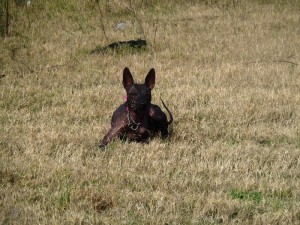 Annata at 14 months old.
Annata at 14 months old.
To follow Annata join our facebook page for the Xolo breed in Australia, click here
https://www.facebook.com/groups/1435764719979982
Facebook learning information Group here
Wazzat XOLOitzcuintle Australia
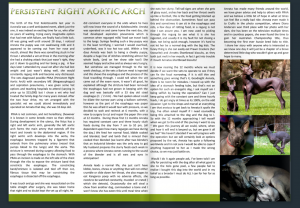
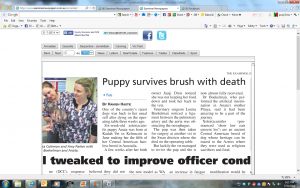
IMMUNE MEDIATED THROMBOCYTOPENIA (IMT)
MAY 2016 The ongoing story of Annata the first born Xolo in Australia, as if life hasn’t dealt her enough blows, NOW it decides to throw another cracker at her. UPDATE on Annata, it has been confirmed by Murdoch Specialist Vets that Annata has Idiopathic Immune Mediated Thrombocytopenia. We are back for regular blood tests ( first being tomorrow) This is not vaccine related, just one of those things that “ONLY” us could get lol It is not genetic, I think its mother Nature trying to tell us Annata should not be here, and she may be right, however we will do all we can to keep her here and keep her to her high style of living as s…he is an amazing Xolo and a great breed ambassador for her tenacity to face fear head on. A little about her problem….which is ……. Immune-mediated thrombocytopenia (IMT) is a very serious autoimmune disease in which a dog’s body attacks its own blood platelets as though they are a pathogenic bacteria or virus. Thrombocytopenia is the technical word for low platelet count.
Platelets are components of blood produced in bone marrow. They are critical to blood clotting during what is called primary hemostasis — the clotting that takes place immediately after an event that damages a blood vessel.
When the body’s platelet count is depleted, severe bruising or uncontrolled bleeding can occur. Excessive bleeding and bruising can lead to anemia (a low red blood cell count), and if left untreated, death can result.
The story goes May 10th 2016, Annata had been drinking a fair bit for a few days, nothing unusual but noted, on the 10th she had loose stolls again, nothing really out of the ordinary, but noted. It was the ocean retreating before the tsunami (so I know now) Roll on to 11.30pm at night, a chilling curdled shout from my husband, to “Hurry in and check Annata” Annata was coughing, and blood was pouring from her nose and large blood amounts were vomited onto the bed. The blood continued to spray everywhere, it was clear it wasn’t going to stop, it is one of the most awful things I have seen, and I was totally helpless to stop it, immediately I went to the afterhours vet. The local vet at 12.10am was not amused but took blood tests and noticed small capillaries in her gums were bruised, he checked her body and noticed bruising (ever so slight) which thankfully could be seen easily on a hairless dog, I am at a loss at to how people with coated dogs would see bruising. The Vet recommended that we immediately head to Perth to the Emergency Vets in the city (a mere 2 hours away) . He stated she needed platelets immediately and he would call them to be o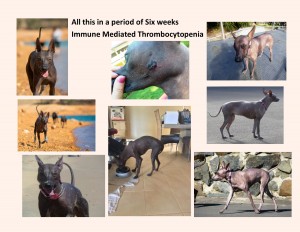 n standby, so blood could be thawed and ready for infusion as we got there. Not wanting to risk anything I went home swapped cars, got Ananta’s food bag and travelled to Perth arriving at 3 am. The staff at the biggest teaching hospital took her and decided to keep her in overnight as she had what they suspected was thrombocytopenia, how could this happen to a dog that has been through so much I asked myself. The next day it was confirmed it was idiopathic immune mediated thrombocytopenia, which just means that we know that her immune system is destroying her platelets but we do not have a reason as to why. For the majority of dogs where their immune system starts attacking their platelets there is never an underlying cause and while there are numerous hypotheses its not really known what causes the immune system to start functioning badly. The first few days are critical and it was touch and go, but we remained positive, Annata was treated with prednisolone and vincristine and hopefully this will work with her immune system being suppressed and help stop it destroying her platelets, although we were told not to expect to see the numbers start to rise again for about 3-5 days. The below pics are the bruising which was evident under the skin at Day 2, any pressure, i.e. lead, collar, can lead to the bruising and a subsequent bleed. She has been bleeding on and off from her nose and had some blood in her faeces, this is ok as they can see the blood, but if she has an internal bleed (tummy, brain etc.) this is not good and will mean the end, there is no coming back from an internal bleed. These first few days are critical; the platelet count was 0 on Wed, a few days later it was 4, to be out of the 50/50 survival she needs to be at 30. A normal dog is in the hundreds, I have never prayed to everyone, anyone and been so worried in my entire life.
n standby, so blood could be thawed and ready for infusion as we got there. Not wanting to risk anything I went home swapped cars, got Ananta’s food bag and travelled to Perth arriving at 3 am. The staff at the biggest teaching hospital took her and decided to keep her in overnight as she had what they suspected was thrombocytopenia, how could this happen to a dog that has been through so much I asked myself. The next day it was confirmed it was idiopathic immune mediated thrombocytopenia, which just means that we know that her immune system is destroying her platelets but we do not have a reason as to why. For the majority of dogs where their immune system starts attacking their platelets there is never an underlying cause and while there are numerous hypotheses its not really known what causes the immune system to start functioning badly. The first few days are critical and it was touch and go, but we remained positive, Annata was treated with prednisolone and vincristine and hopefully this will work with her immune system being suppressed and help stop it destroying her platelets, although we were told not to expect to see the numbers start to rise again for about 3-5 days. The below pics are the bruising which was evident under the skin at Day 2, any pressure, i.e. lead, collar, can lead to the bruising and a subsequent bleed. She has been bleeding on and off from her nose and had some blood in her faeces, this is ok as they can see the blood, but if she has an internal bleed (tummy, brain etc.) this is not good and will mean the end, there is no coming back from an internal bleed. These first few days are critical; the platelet count was 0 on Wed, a few days later it was 4, to be out of the 50/50 survival she needs to be at 30. A normal dog is in the hundreds, I have never prayed to everyone, anyone and been so worried in my entire life.
The Bruising evident on the skin when the blood is clotting, one of the first signs of IMT.
.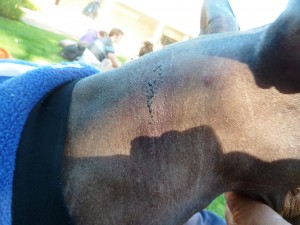
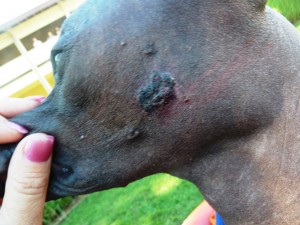
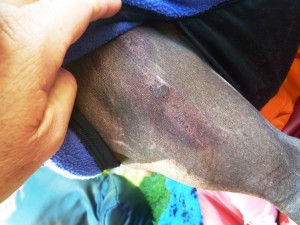
Annata was cared for by the wonderful Dr Lexie BROWN, Nurse Dee and staff at Murdoch University for 13 days, then we were allowed to take her home, I’m not sure if she was discharged early as I threatened to camp in the University car park to feed her every three hours, or she was really ok to go home, however I was very grateful she could go home. We travelled to the vets every second day, then weekly for blood tests, as soon as Dr Lexie was happy we were allowed to have two weekly bloods taken in Bunbury, which saved a lot of driving. The drugs Annata was on, Azathioprine and Prednisolone changed her body colour and her shape a lot, her character, demeanor, eating habits all changed, the only upside was it made her very easy to feed, she was like a monster with food, I soon learnt jumping 4ft to get food was the norm, and always a race to the other dogs food bowls. This in itself was to prove almost fatal a few weeks later so we would find.
The blood tests were always a worry but also exciting as it showed we were making progress, sometimes we would be prescribed antibiotics for bugs which she would pick up, even though we limited her exposure a great deal and were super cautious with cleaning everything to eliminate any risk.
Gradually the prednisolone was weaned down and in September we were Prednisolone free, still on the Azathioprine, but working towards reduction on Az as well. A slight hiccup early October saw the reintroduction to 1 mg Prednisilone, however it is felt this was due to a large piece of meat that had become lodged in her esophagus (at the stricture point) . When food becomes lodged here and cannot be passed through the narrowed esophagus, any food given builds up behind this and creates a rotting effect in her pouch, we feel this caused a slight infection and affected her blood readings.
Annata two months into treatment losing her colour, the cocktail of drugs keeping her alive was not kind
With all Annatas foods being slurry anything bigger than a slurry is easy to cause a blockage, even though the adult dogs are fed in other areas as are pups sometimes, I am not quick enough and Annata can get to foods that she can crunch on, that’s lovely but they get lodged and stuck. Having food lodged and stuck means nothing going in and certainly nothing coming out, its a rush to Murdoch and a Micro Camera and Micro pair of tweezers ( that look like strands of human hair) that pluck the food out piece by piece over a few hours. We were very fortunate when this was done Dr Lexie stayed back to operate and Proff Peter IRWIN came in to supervise, I was thrilled when Prof IRWIN actually stated, he had heard Annata was coming in and he came in to Murdoch even though it was after hours. I was very grateful. This was JULY 2016
This is a video of the retrieval operation performed at Murdoch ( Shorter version) the whole long process is also on the Wazzat Xolo Channel on You Tube.
Annata Retreival Operation link Annatas letter from Her Majesty the Queen
Whilst IMT is not considered breed related, it isn’t known if hereditary and clinical tests are still being conducted, being condemned by people who choose to hide problems, really says more about them than I. I will always share and am thankful that the honest people I source my dogs from and the people I let show my dogs here in Australia understand that I will not hide anything in any Wazzat Xolo. Whilst some breeders may choose to not share and sweep health issues under the carpet I choose to share fully anything, so people may learn and dogs (including the breed) may be healthier from research and data collected. If a breeder will not share all with you, ASK, can you trust that breeder, watch closely who people work with and the results speak for themselves.
Annata Perth Royal Show October 2016
Watch Annatas amazing C Section Birth here
Annata BIRTH
WHAT IS IMT By Dr. Becker
Immune-mediated thrombocytopenia (IMT) is a very serious autoimmune disease in which a dog’s body attacks its own blood platelets as though they are a pathogenic bacteria or virus. Thrombocytopenia is the technical word for low platelet count. Platelets are components of blood produced in bone marrow. They are critical to blood clotting during what is called primary hemostasis — the clotting that takes place immediately after an event that damages a blood vessel.
When the body’s platelet count is depleted, severe bruising or uncontrolled bleeding can occur. Excessive bleeding and bruising can lead to anemia (a low red blood cell count), and if left untreated, death can result.
Symptoms of Immune-mediated Thrombocytopenia
Most of the clinical signs of IMT are bleeding-related. Common symptoms include lethargy, weakness, increased respiratory rate, bruising, bleeding from the mouth or nose, pale gums, and dark, tarry stools that indicate the presence of blood in the GI tract.
Less common signs of IMT are breathing difficulties, including significantly increased respiratory effort, and sudden death.
Diagnosis and Treatment Options
Diagnosis involves confirming the problem is immune-mediated thrombocytopenia by ruling out all non-immune related causes and other primary conditions that can bring on thrombocytopenia as a secondary condition. Disorders associated with secondary thrombocytopenia in dogs include viral, parasitic, fungal and bacterial diseases, certain types of cancer, and the administration of certain drugs.
Diagnostic tests will include some or all of the following: a complete blood count (CBC), chemistry profile, coagulation testing, titers for infectious diseases, an anti-nuclear antibody (ANA) test to evaluate immune response against DNA, urinalysis, chest x-rays, and abdominal ultrasound.
IMT is a complex and variable condition, so treatment is individualized. Often aggressive care is required when the disorder is initially diagnosed, and many dogs need to be hospitalized.
The immune system response to blood platelets must be controlled quickly, which, unfortunately, means immunosuppressive drugs like steroids, azathioprine, cyclosporine A and others to save the pet’s life. Homeopathic vets will use homeopathic remedies for vaccinosis before turning to drug therapy. However, if animals don’t respond to natural therapies, immunosupressive drugs will be required to save the pet’s life.
If anemia is present, a blood transfusion may be required. Supportive care in the form of oxygen and fluid therapy may be given.
Underlying diseases must be identified and treated to help control the IMT and lower the risk of recurrence.
Longer term, the dog will require immunosuppressive and other drugs based on symptoms. It’s not unusual for a dog to be on immunosuppressive drugs for several months after initial diagnosis. Supportive herbs, such as milk thistle can be used at this time to help reduce stress on the organs of detoxification.
Any drugs or vaccines the dog received prior to developing IMT should be avoided for the rest of the dog’s life, as should all vaccinations and other immune system stimulants (more about this shortly).Most dogs with IMT can live normally if they respond well to medical treatment. Generally speaking, if a dog does well during the acute phase of the disease and throughout treatment, he has an excellent chance of doing well long term.
Many dogs can be weaned from all medications, but occasionally a dog may require intermittent drug therapy for the rest of his life. These dogs are good candidates for integrative medical care, which can help reduce flare-ups of autoimmune reactions and reduce the need for long term drug therapy.
Controversy Over What Causes IMT
A study conducted by the Department of Veterinary Clinical Sciences at Purdue University and published in the Journal of Veterinary Internal Medicine, failed to confirm a link between idiopathic immune-mediated thrombocytopenia (IMT) and recent vaccination. Thankfully, the Purdue researchers also noted that, “… the possibility of an association cannot be completely ruled out based on the small sample populations and requires further investigation.”
